How to properly replace the mixer yourself?

There are times when you urgently need to replace the faucet in the bathroom or in the kitchen, but a familiar specialist is not around. In addition, it is night in the yard, and it is not always possible to call a plumber into the house during the day. There remains only one option for the owner - to replace the faulty mixer on his own.
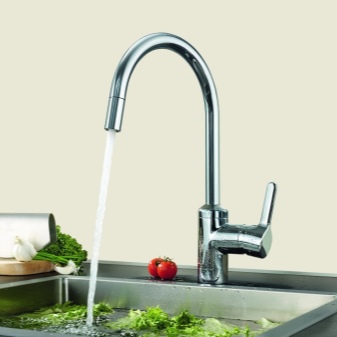
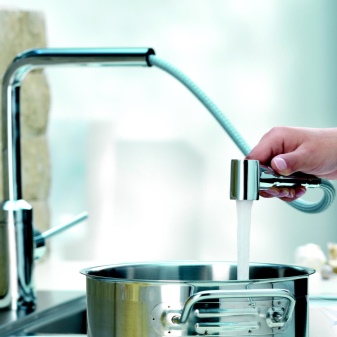
Peculiarities
If there is a new or serviceable second-hand crane in stock, then replacing the defective fittings will not be difficult for those who have at least once been involved in a similar business. But for people who do not distinguish between open-end wrenches and socket wrenches, it will be difficult to explain how you can do this yourself. But you have to try, since such a need arose.
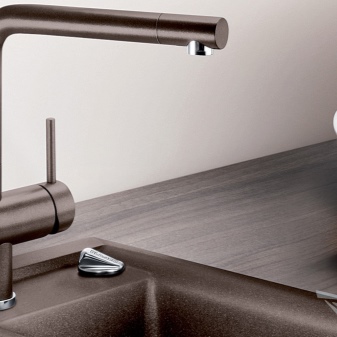
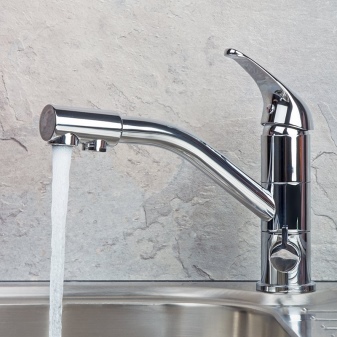
Before removing a faulty mixer, you should perform the following mandatory steps to protect your own and other people's property from flooding:
- Close the primary valves for supplying hot and cold water to an apartment or house from common risers. In old houses, it was often not possible to turn off the water to a specific apartment, since the piping was supposed to install only a common valve for the entire entrance. There was no separate fittings on the branches to each apartment. Modern zhilstroy has eliminated this inconvenience - now each apartment has its own disconnecting devices on cold and hot water pipelines.
- If the primary valve in a modern apartment is out of order, then the work is added. It is necessary to notify the neighbors at the entrance that hot and cold water will be absent for some time due to an accident in the apartment, and then turn off the riser in the basement.
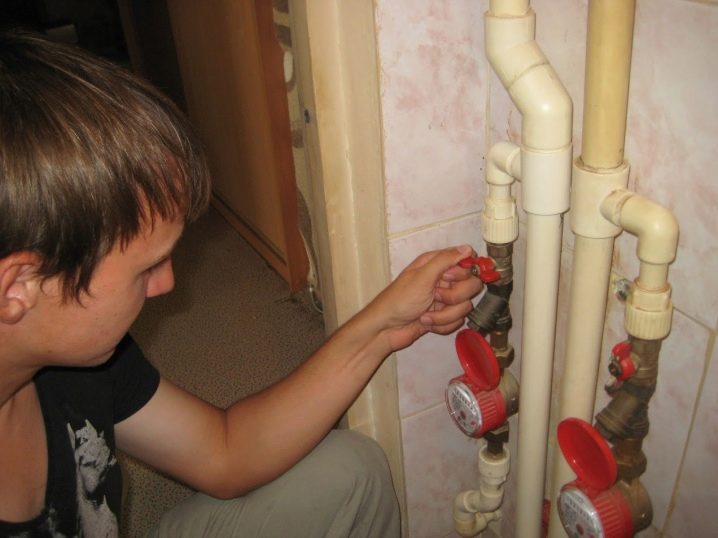
- If the primary valve for the entire entrance in the house of the old building does not hold (also a frequent incident), then it will be problematic to immediately resolve this issue. We'll have to call the emergency housing and communal services. Not all houses have a through passage in the basement, and the common gate valve to the house may not be in the basement of the house, but somewhere in the well in front of the building.
- Having closed, finally, everything you need and making sure that there is no water in the taps, you can start replacing the mixer.
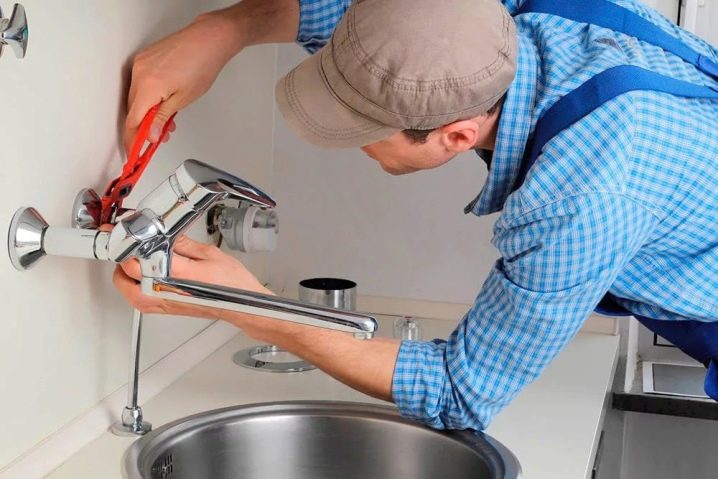
All the described actions should be performed first of all if inaction threatens to flood your own and below located apartments. It doesn't matter if other mixers or spare parts are available. Even if there is nothing in stock, then one day or night can be tolerated.
When the threat of flooding is eliminated, then it is necessary to thoroughly understand the problem that has arisen. Consider the mixer, find out the cause of its malfunction and the possibility of repair.
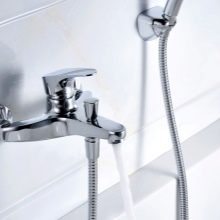
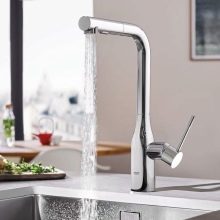

How to make a replacement?
Sometimes, in emergency situations, it is not necessary to have a new or serviceable used mixer in order to temporarily eliminate a difficult situation. The thrifty owner has separate serviceable parts of the mixer: "ganders" with elements of connection to the mixer, gaskets, valve boxes assembled or disassembled. All this can be useful depending on a malfunction with an existing shut-off valve that has become unusable. With the help of spare parts, you can repair the mixer, even if for the first time.
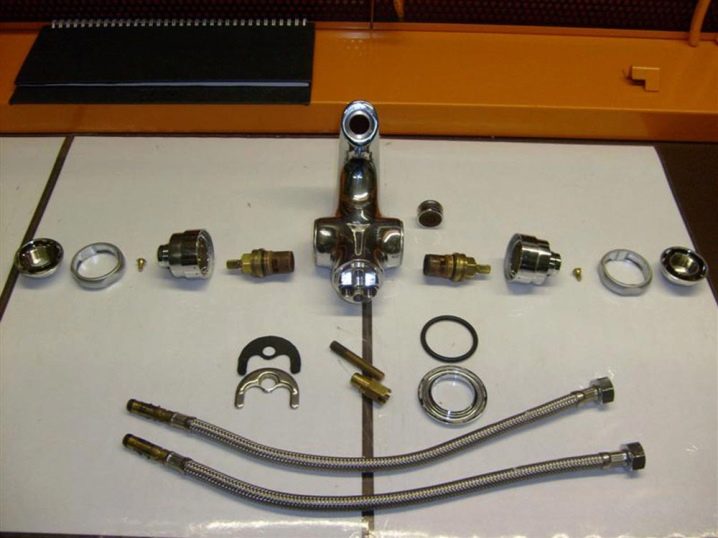
Both to replace the mixer and to repair it, you will need a running set of tools, which is in stock with any person who understands in the slightest degree in life.This set includes various open-end keys from number 8 to number 32 for possible everyday worries with plumbing and plumbing in the apartment. It is not superfluous to have an adjustable wrench on hand for unforeseen nut sizes both in plumbing and in furniture assembly. A gas key is often in demand on the farm, which is needed not only for work on the gas pipeline, but also for the same plumbing work.
The gas wrench is always useful for the water supply system and its fittings.
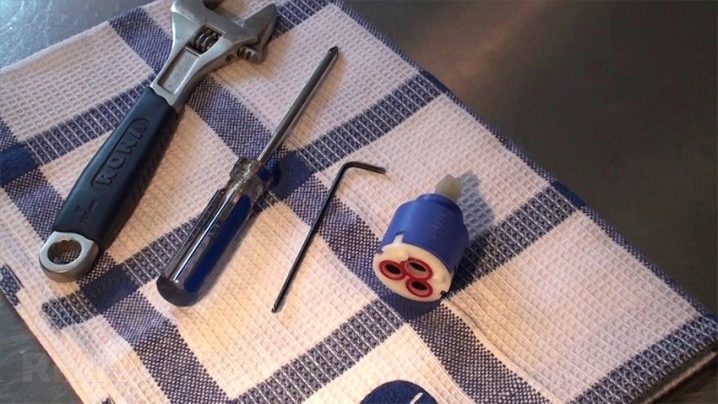
In addition to tools, the house always needs an assortment of spare parts and various consumables for the repair of plumbing and plumbing. The following elements are most in demand for the repair of water taps and mixers:
- rubber or plastic gaskets;
- valves;
- valve stems;
- handwheels of valves;
- connecting and transitional parts with a pipeline, including nipples (barrels), couplings, nuts;
- material for sealing joints.
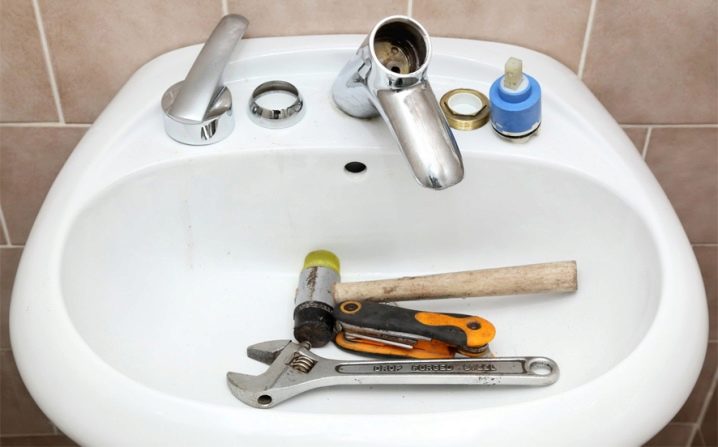
A nipple (aka a barrel) is a pipe connecting piece that has an external thread of the same or different diameter and pitch on both sides. It can be used for joining two pipelines, a pipeline and a tap, as well as in other cases of installation or repair of a water supply system.
When the mixer malfunction can be easily eliminated by ordinary replacement of gaskets, and the leak at the joints to the pipelines by a slight tightening, then such an "accident" can be considered an easy misunderstanding. But if everything is more serious, and the replacement of the mixer cannot be avoided, then you have to roll up your sleeves and drag the tool and spare parts to the place of work.
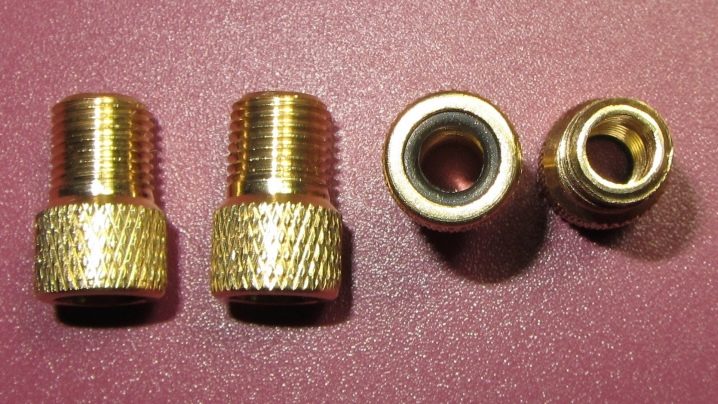
How to replace it yourself with your own hands?
In the bathroom of modern apartments, there can be two options for installing mixing taps.
- One faucet, acting both for the supply of water to the bathroom, and for the washbasin.
- Two separate taps: one for shower and bath water only, the other for washing in the sink.
These two separate mixing taps are completely different designs. For the sink, a single-arm faucet (or a conventional two-valve) is usually used, and for a bath, a two-valve with a shower switch. It would be better to first consider an example of replacing a valve for a water supply to a bath and shower.
There are models of single-lever (single-lever) bath taps, but it doesn't matter when it comes to replacing them: the supply of hot and cold water is the same everywhere.
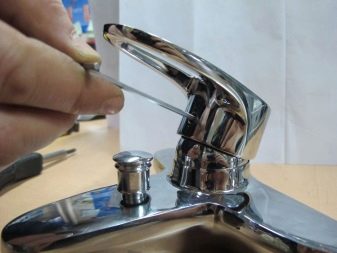
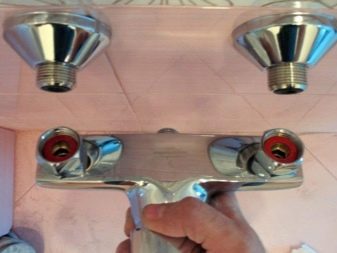
Valve mixer
Before starting to dismantle the mixer and begin to unwind its joints with cold and hot water pipelines, you should pay attention to the material of the pipelines. If the supply pipes are steel and no longer have any connections, then you can safely unscrew the nuts. In the case of pipes made of metal-plastic or polypropylene, this must be done very carefully, slightly clamping the inlet pipe with a suitable tool and at the same time unscrewing the fixing nuts of the mixer. Do not allow twisting of plastic pipes, otherwise the problems will be even more serious.
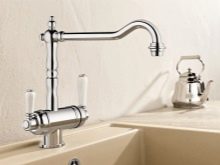
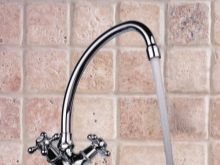
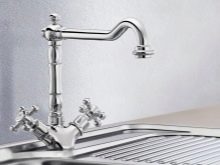
It is better to clamp not the plastic pipe itself, but a metal eccentric adapter, which is usually installed by installation organizations when installing water mains and wiring to apartments. This adapter is also a type of nipple that has two threads at its ends. One of them is screwed in or soldered after adjusting the distance between the pipelines to the standard of the mixers, and the other is intended for connecting the tap.

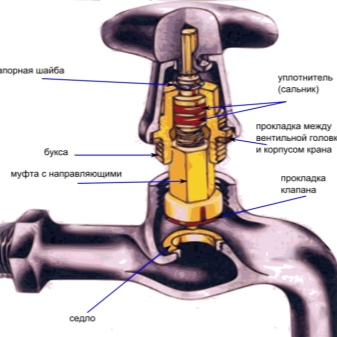
Step-by-step instructions for removing a mixer in a bathroom or kitchen with a standard type of supply pipelines consists of several points:
- Shut off the hot and cold water with the primary valve. Options for finding them in a newly built apartment: cold water in the toilet, hot water in the bathroom. There are apartments in which each tap has its own shut-off valve. In older houses, the valves are in the basement. But still, first you should carefully examine the pipelines in the apartment.
- By opening the valves on the mixer, which needs to be changed, drain the water from the pipeline and the device itself. It is advisable to open all the remaining taps in the apartment, so as not to leave the system even under the atmospheric pressure of the water remaining in the pipes.
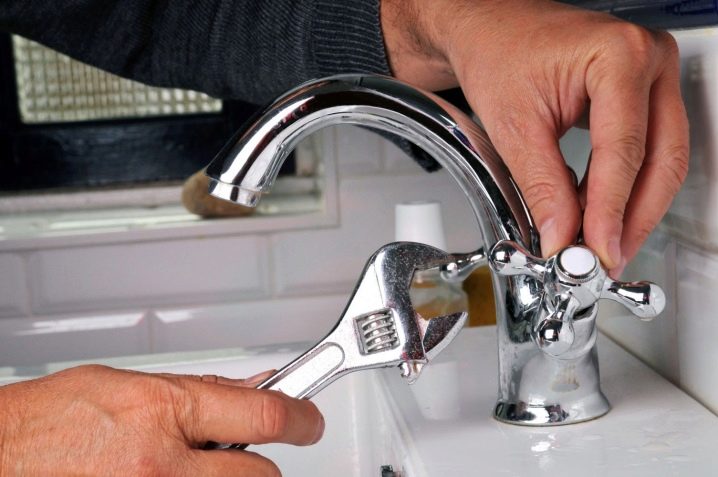
- Prepare tools, spare parts, consumables. Just in case, take care of a rag and a bucket, so that there is somewhere to drain the water and how to wipe up the puddles. From tools and consumables you will need: two adjustable wrenches (or one adjustable wrench and a set of open-end wrenches), pliers, special Teflon tape or thread for sealing threaded connections, masking or insulating tape, liquid for softening scale and rust. If something is not available, then the work will have to be postponed for a while. The last in the list may not be needed if the connections are in good condition.
- Simultaneously loosen the mixer fixing nuts on both eccentric adapters. Perhaps there is not all the water from the mixer or glass pipes, therefore, before unscrewing the mount, it is better to lay a dry cloth under the eccentrics or substitute the dishes to keep the workplace clean.
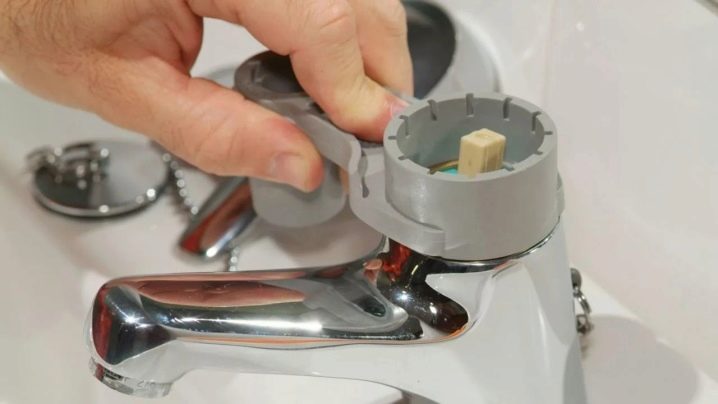
- It can be expected that the stuck threads on the joints will not give in the first time. You should not tempt fate and make super-powerful efforts to achieve the goal. Plumbing and plumbing in the household are the most unpredictable systems for a comfortable life for a person. At every opportunity, they try to win back, and turn heavenly life into a living hell. And with synthetic newfangled pipelines, no effort should be made.
- Try to unwind the bonded joints, and if there is a liquid for this, then apply it as directed by smearing or applying a rag soaked in the liquid to the problem area. Allow time for limescale or rust to soften, and then try to unscrew the nuts. You can also use vinegar, heated oil, kerosene instead of a special liquid. Nothing is impossible, so in the end the nuts will come loose.
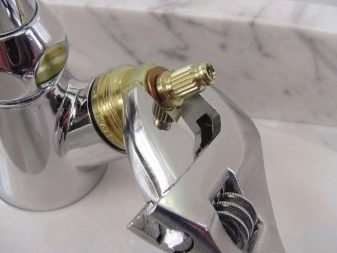
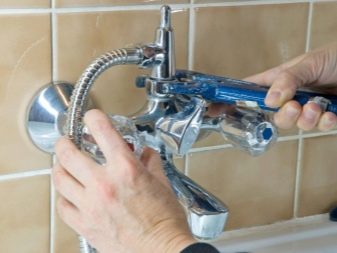
- Having unscrewed the mixer nuts from the adapters, remove the faulty mixer. Prepare and assemble a new valve if disassembled.
- Usually new mixers have eccentric adapters in their kit. If it is possible to remove old eccentrics, then it is better to do this without hesitation. For example, in the case of plastic supply pipes, this operation is unlikely to succeed, and problems with steel water supply will not arise. Remember the position and unscrew the old eccentrics from the supply pipes, and clean the connection point of dirt. Wrap the threads on the new adapters with 3-4 layers of Teflon tape and screw them with compression into the water pipes in the same position in which the old adapters stood.

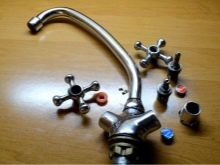
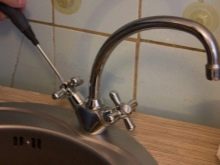
- Now wrap Teflon tape around the second end of the adapter to which the mixer will be attached. It is enough to wrap the entire threaded part of the eccentric with tape 3-4 times.
- Install the fixing nuts of the mixer on the eccentrics of both pipelines, being careful not to distort or damage the threads either on the nuts themselves or on the eccentrics. Tighten both connections synchronously until the nuts slide tight.
- Wrap with masking or insulating tape to protect the chrome-plated surfaces of the fastening nuts, tighten them with a wrench or pliers.
- Remove the masking tape. Adjust the tightness of all other fasteners on the mixer (gander, shower hose).
- Check the tightness and correct operation of the taps by supplying water alternately from each pipeline.
There is nothing complicated in replacing a valve mixer. Such work can be done independently in an hour with the presence of primary water fittings, tools and the necessary materials.
And the quality of work depends on the attentiveness and reasonable approach to the business of the owner.
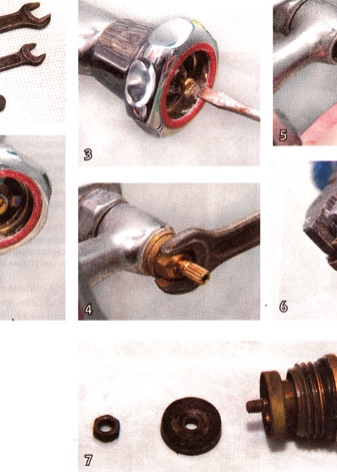

Single lever crane
Single-lever (single-lever) kitchen and bath faucets are more convenient than their predecessors - valve taps:
- Can be operated with only one hand. The valve taps for adjusting the water supply to the desired temperature can be controlled by holding and twisting each lamb simultaneously or alternately with both hands.
- Setting the temperature with a single lever is almost instantaneous and keeps it stable, which is not the case with two-valve taps.
- Such valves are usually now either with a ball mechanism, or with a cartridge consisting of a cassette with ceramic discs inside. These working elements of the mixer can be easily replaced by yourself without calling the plumbers. The parts themselves cannot be repaired at home.
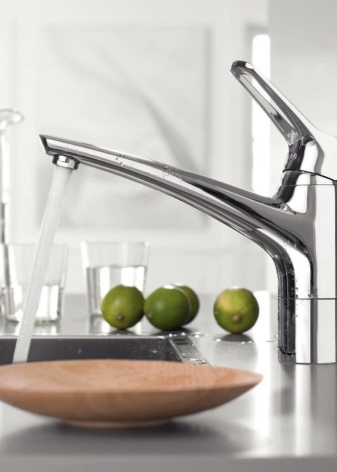
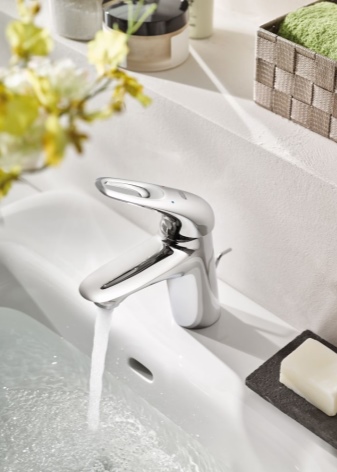
Of the shortcomings of the described taps, their high demands on the quality of tap water are especially noted. Blocked by mechanical impurities contained in the water, they begin to work unsatisfactorily over time: they leak, wedge in the hinges, the jet power and flow rate decrease, the taps become loose and do not hold water when closed. To increase the service life of the valves, the best solution is to install filters on the supply pipelines. The cost of one filter is cheap, and the effect of their installation is amazing: the taps will last many times longer than without filters.
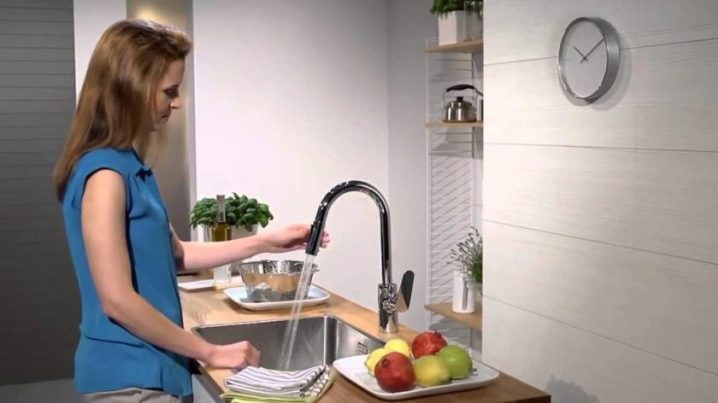
Malfunctions of a single-lever valve with a cartridge are explained by the failure of the following parts:
- ceramic cartridge;
- cracks in the case;
- breakage of metal sealing elements (or corrosion);
- wear of rubber seals.
All these elements, except for the body, must be replaced. In case of cracks in the housing, the entire device must be replaced with a new one. Cracks can form due to careless installation or the use of low-quality materials by the manufacturer.
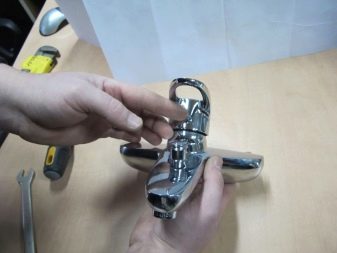

Replacing the cartridge consists of the following sequential steps:
- The water supply is turned off by the primary valves on the hot and cold water pipelines to the apartment.
- The pressure in the pipelines is relieved by opening the valves, including the one being repaired.
- The decorative plug is pulled out from the hole under the tap lever, in which there is a screw that fixes this lever. You can use a flat screwdriver for this.
- Unscrew the fixing screw by 1-2 turns and remove the handle. You need a screwdriver or a special hex key to unscrew the screw.
- Remove or unscrew by hand the decorative half-ring from the valve body. A clamping nut becomes available, which fixes the position of the cartridge in the valve body, and the valve stem.
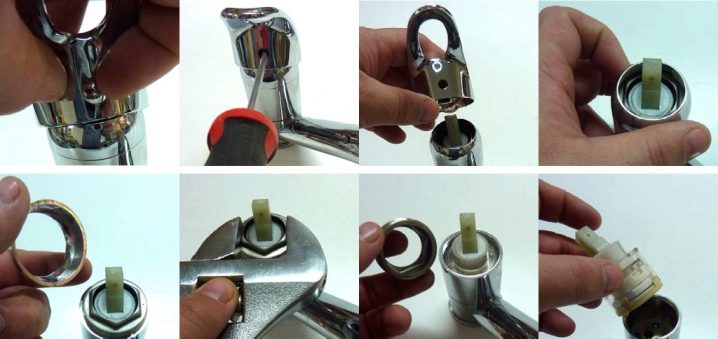
- Carefully loosen the compression nut using an open-end wrench or adjustable wrench of a suitable size.
- Remember the position of the cartridge in the seat and then pull it up from the body. The old element should be replaced in exactly the same way: with the appropriate diameter (30 or 40 mm) and the arrangement of cassette holes.
- Before replacing the cartridge, clean the seat from possible scale, rust and other debris. And also inspect the O-rings and replace if they are worn out or deformed.
- Install a new element, keeping the position of the old one. It will not be possible to put the device in another way, for this there are special grooves and barbs, but careless installation can lead to damage to the product.
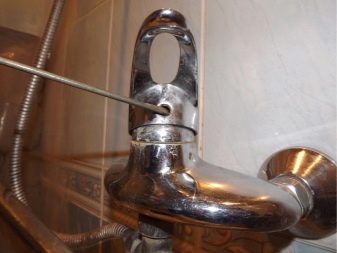
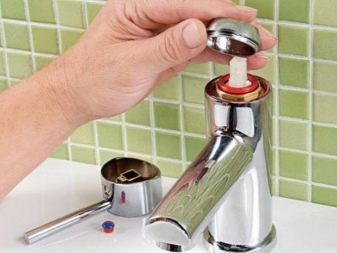
- Tighten the jam nut, securing the device securely in the body and seat.
- Reinstall the dummy half-ring.
- Fasten the tap lever with the screw.
- Check the results of work by supplying water.
It should be noted that the presented algorithm of operation is quite suitable for valve mixers if it becomes necessary to change or repair the crown (crane-axle box) of one of the valves.
Almost the same operations.

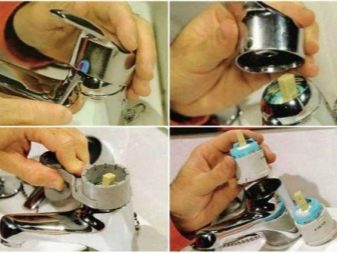
Ball mixers are distinguished by their longevity compared to cassette mixers, they are less responsive to water quality, but practically cannot be repaired. Any breakdown leads to a complete replacement of the crane. The only case when disassembly of the tap is required is associated with a decrease in water flow through it due to clogging of the strainer on the drain. The tap is disassembled, and the filter is cleaned as follows:
- disconnect the "gander" from the mixer body;
- unscrew the nut with the filter from the drain chamber;
- clean the filter mesh by blowing and rinsing in the opposite direction from the working stroke of the flow;
- clean the "gander" itself and its fastening part from deposits;
- assemble the structure in the reverse order of disassembly.
Single-lever taps are installed both in the bathroom and in the kitchen. They can be of different designs, with or without shower switches. In the bathroom, they are often installed in a separate tulip sink. They are also installed in conventional washbasins.

Algorithm for the complete replacement of cranes for any of these designs:
- Turn off the water and release the pressure by opening the taps.
- Free the place of work from unnecessary objects and sewer pipelines that can interfere with free access to the fixing nuts of the mixer.
- If the sink is of the "tulip" type, then you need to remove the pedestal for ease of use. In other cases, when the fastening of the sink is not very reliable (for example, there is no bolt, the dowels are loose), you will have to remove the sink. At the same time, you can fix it. But first, disconnect the flexible hoses from the pipes to the mixer. They must be disconnected from the pipes, not from the mixer.
- Unscrew the fixing device under the sink. There is a metal plate with a gasket, which is held by two fastening pins with 10 nuts (there are 8). These nuts must be unscrewed using a suitable socket wrench from a special set made from a long tube. Spanner wrenches are also suitable.

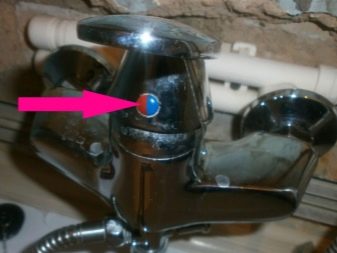
- Having unscrewed the fastener nuts, partially pull the valve outward and unscrew the flexible pipes. It will not be possible to completely remove the tap from the hole of the sink, the fastening plate interferes. After unscrewing the hoses, the tap, plate and hoses become loose spare parts.
- Prepare a new device with accessories (hoses, mounting plate with nuts and gaskets).
- The device must be fully assembled with an upper O-ring and gasket.
- Clean the hole for the device in the sink from the bottom and top of the dirt.
- First thread the rubber seal onto the flexible cables, and then the fastening plate from the side of the mixer connection and push them into the hole from below.
- Screw the cables into the bottom of the tap and tighten securely.

- Press the gasket and plate onto the mounting pins with nuts.
- Reinstall tulip shell if removed and reinforce.
- Connect the hoses to the pipes.
- Fasten the mixer with the fixing nuts from the bottom, correctly positioning the upper seal around the circumference of the hole.
- Check the result with water pressure.
Having done this kind of work even once, you can gain good experience for many years.
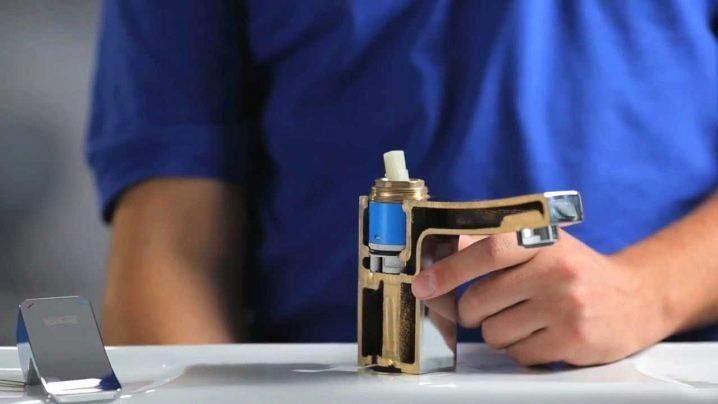
Advice
A few useful tips for novice DIYers:
- If water from the tap began to spray, you need to clean the mesh filter on the "gander".
- Weak stream from the mixer - the holes on the water inlet valves to the mixing chamber are clogged or the filter on the spout of the single-lever tap is clogged.
- Poor water pressure - first clean the filter on the supply pipe. It is possible that a stone has hit it.
- Install check valves after meters and filters.
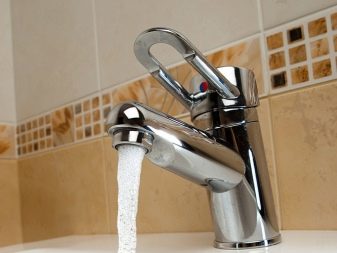
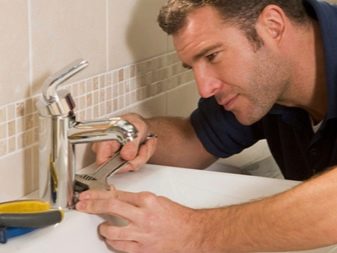
Periodic maintenance work will prolong the operation of the devices. It is necessary to change the gaskets, clean the taps from scale and mechanical impurities, change flexible wiring every 2 years, regularly inspect the joints of pipelines, hoses and seals for leaks.
You will learn more about how to replace the mixer yourself in the following video.













The comment was sent successfully.